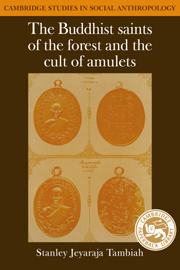Book contents
- Frontmatter
- Contents
- Acknowledgments
- Note on transcription
- 1 Introduction and manifesto
- Part I The arahant and the Path of Meditation
- Part II The hagiography of a Buddhist saint: text and context; the politics of sectarianism
- Part III The cult of amulets: the objectification and transmission of charisma
- 14 The cult of images and amulets
- 15 An enumeration of historic and popular amulets
- 16 The “likeness” of the image to the original Buddha: the case of the Siṅhala Buddha
- 17 The process of sacralizing images and amulets: the transfer of power by monks
- 18 Amulets blessed by contemporary forest saints
- 19 Saints on cosmic mountains
- Part IV Conceptual and theoretical clarifications
- Notes
- Index
- CAMBRIDGE STUDIES IN SOCIAL ANTHROPOLOGY
19 - Saints on cosmic mountains
Published online by Cambridge University Press: 10 December 2009
- Frontmatter
- Contents
- Acknowledgments
- Note on transcription
- 1 Introduction and manifesto
- Part I The arahant and the Path of Meditation
- Part II The hagiography of a Buddhist saint: text and context; the politics of sectarianism
- Part III The cult of amulets: the objectification and transmission of charisma
- 14 The cult of images and amulets
- 15 An enumeration of historic and popular amulets
- 16 The “likeness” of the image to the original Buddha: the case of the Siṅhala Buddha
- 17 The process of sacralizing images and amulets: the transfer of power by monks
- 18 Amulets blessed by contemporary forest saints
- 19 Saints on cosmic mountains
- Part IV Conceptual and theoretical clarifications
- Notes
- Index
- CAMBRIDGE STUDIES IN SOCIAL ANTHROPOLOGY
Summary
Doing well by doing good
I want to describe now the remarkable circumstances by which the Thai world of commerce, banking, and high society concentrated in the country's metropolis organized a pilgrimage to do homage to and to make gifts to the inmates of Acharn Čūan's hermitage on “the barren mountain”. Located on the extreme periphery of the country, the hermitage is in a region that in popular imagination is not only wild and remote, but also infested with insurgency elements and guerrillas threatening the Thai establishment.
Whereas previously I documented how the forest saint's charisma was tapped by the king, the ruling ministers, and the military, a symbiosis that was consonant with tradition, we now face a relatively new situation: Sāsana and high finance come together in a direct partnership in which the banks do well by doing good. Modernization theorists should contemplate this new conjunction between religion and commerce in the context of the spread of capitalism in the Third World.
The Bangkok Bank of Commerce, one of the prominent banks in Thailand, with its headquarters in Bangkok and many branches throughout the country, requested that it be allowed to make the kathin gift to Acharn Čūan's mountain hermitage at the end of the rains retreat in October 1978. The prime mover in this merit making was a Nongkhāi businessman who was also supervisor of the Bangkok bank's five branches in five Northeastern towns – Nongkhāi, Udon, Nakhon Phanom, Thābāū, and Mukdāhān. Let us call him Mr. Lai. He was already a disciple (luksit)of Acharn Čūan, and he therefore proposed to the bank as a whole that it make its annual kathin gift to Acharn Čūan's hermitage.
- Type
- Chapter
- Information
- The Buddhist Saints of the Forest and the Cult of Amulets , pp. 274 - 290Publisher: Cambridge University PressPrint publication year: 1984



